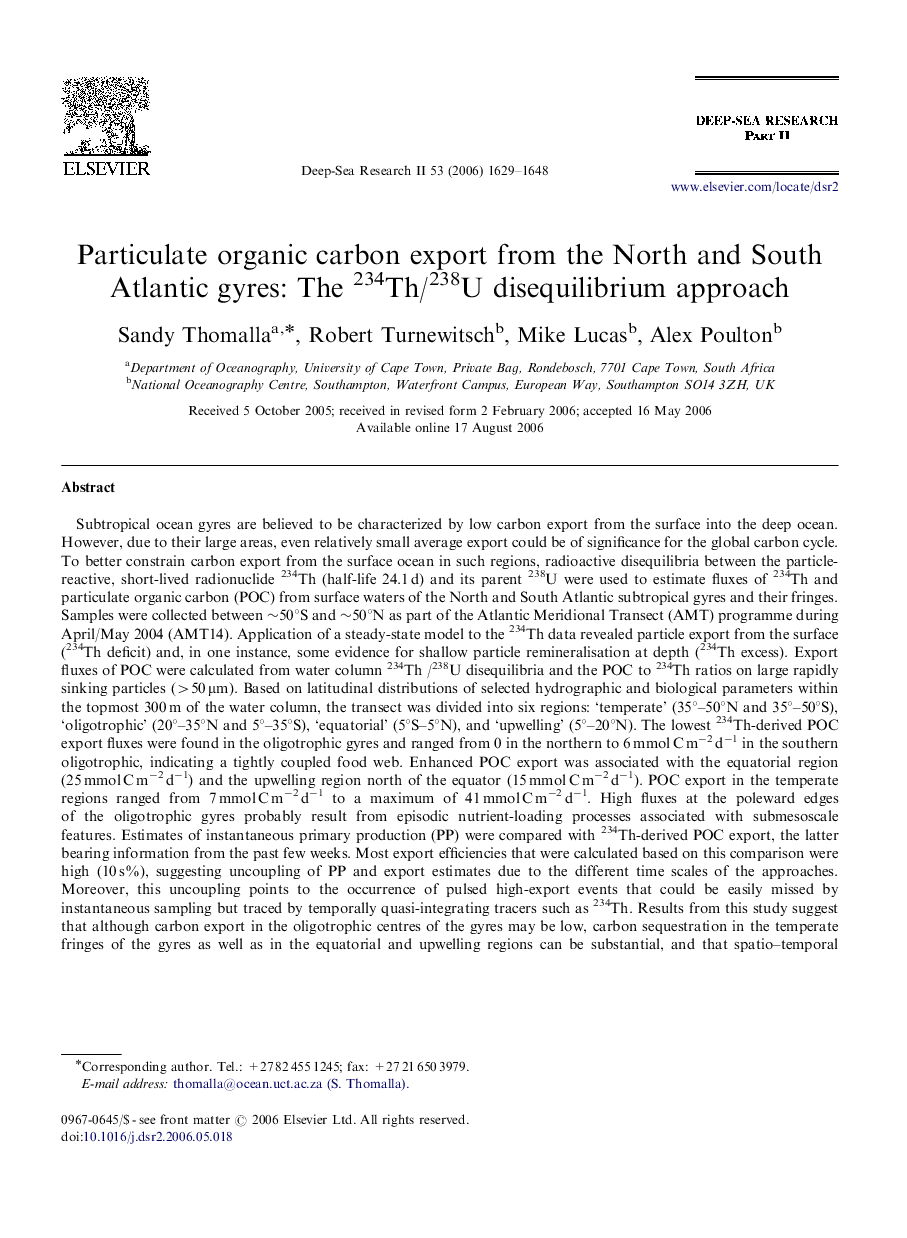| کد مقاله | کد نشریه | سال انتشار | مقاله انگلیسی | نسخه تمام متن |
|---|---|---|---|---|
| 4538456 | 1626514 | 2006 | 20 صفحه PDF | دانلود رایگان |

Subtropical ocean gyres are believed to be characterized by low carbon export from the surface into the deep ocean. However, due to their large areas, even relatively small average export could be of significance for the global carbon cycle. To better constrain carbon export from the surface ocean in such regions, radioactive disequilibria between the particle-reactive, short-lived radionuclide 234Th (half-life 24.1 d) and its parent 238U were used to estimate fluxes of 234Th and particulate organic carbon (POC) from surface waters of the North and South Atlantic subtropical gyres and their fringes. Samples were collected between ∼50°S and ∼50°N as part of the Atlantic Meridional Transect (AMT) programme during April/May 2004 (AMT14). Application of a steady-state model to the 234Th data revealed particle export from the surface (234Th deficit) and, in one instance, some evidence for shallow particle remineralisation at depth (234Th excess). Export fluxes of POC were calculated from water column 234Th /238U disequilibria and the POC to 234Th ratios on large rapidly sinking particles (>50 μm). Based on latitudinal distributions of selected hydrographic and biological parameters within the topmost 300 m of the water column, the transect was divided into six regions: ‘temperate’ (35°–50°N and 35°–50°S), ‘oligotrophic’ (20°–35°N and 5°–35°S), ‘equatorial’ (5°S–5°N), and ‘upwelling’ (5°–20°N). The lowest 234Th-derived POC export fluxes were found in the oligotrophic gyres and ranged from 0 in the northern to 6 mmol C m−2 d−1 in the southern oligotrophic, indicating a tightly coupled food web. Enhanced POC export was associated with the equatorial region (25 mmol C m−2 d−1) and the upwelling region north of the equator (15 mmol C m−2 d−1). POC export in the temperate regions ranged from 7 mmol C m−2 d−1 to a maximum of 41 mmol C m−2 d−1. High fluxes at the poleward edges of the oligotrophic gyres probably result from episodic nutrient-loading processes associated with submesoscale features. Estimates of instantaneous primary production (PP) were compared with 234Th-derived POC export, the latter bearing information from the past few weeks. Most export efficiencies that were calculated based on this comparison were high (10 s%), suggesting uncoupling of PP and export estimates due to the different time scales of the approaches. Moreover, this uncoupling points to the occurrence of pulsed high-export events that could be easily missed by instantaneous sampling but traced by temporally quasi-integrating tracers such as 234Th. Results from this study suggest that although carbon export in the oligotrophic centres of the gyres may be low, carbon sequestration in the temperate fringes of the gyres as well as in the equatorial and upwelling regions can be substantial, and that spatio–temporal variability in these areas of the world's oceans needs to be considered more fully in the context of global oceanic carbon sequestration.
Journal: Deep Sea Research Part II: Topical Studies in Oceanography - Volume 53, Issues 14–16, July–August 2006, Pages 1629–1648